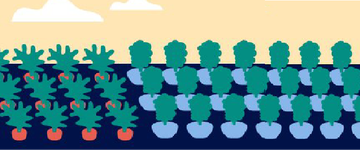Better Food Systems
SUSTAINABLE AGRICULTURE
The second biggest source of carbon pollution is farming. Right now, natural habitats like rainforests that 'fix’ more carbon than farmland are being cleared, and the soil on farms also ejects carbon because it is less healthy. But modern sustainable agriculture can help us to farm more crops in less space, so that we can restore old farmland to wilderness. Sustainable agriculture also uses less water, and less or better pesticides and fertilizers, all of which helps to protect biodiversity.
LESS MEAT
We can also eat less meat. This is because livestock need more land and water than crops, but also because they belch and fart the potent greenhouse gas methane. Cows are the biggest contributors, meaning that cutting beef and dairy from your diet can halve the carbon footprint of your food. We can also eat more meat and dairy substitutes which are being developed around the world. Want to sound really clever? The proper name for animals producing methane is ‘enteric fermentation’.
LESS FOOD WASTE
The food we waste is also a problem. Much of this happens before the food gets to the people who eat it, on the farm, during transport, or at the shops. It also happens after, when people throw food away. Rotting food gives off methane whether in the field or in landfill. Food we don’t eat also means the carbon that went into making it is ‘wasted’. By improving what governments pay farmers to grow (something called subsides), as well as the way we grow, transport, buy, and store food, we can reduce much of this waste.
Average Rating: ★ ★ ☆ ☆ ☆ (4 reviews)


